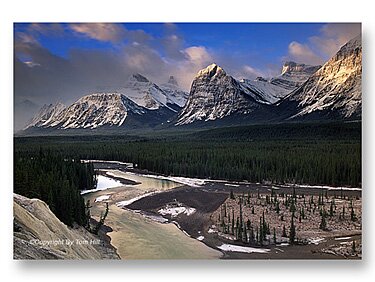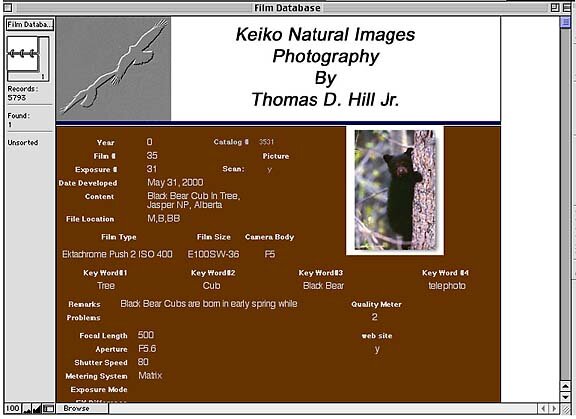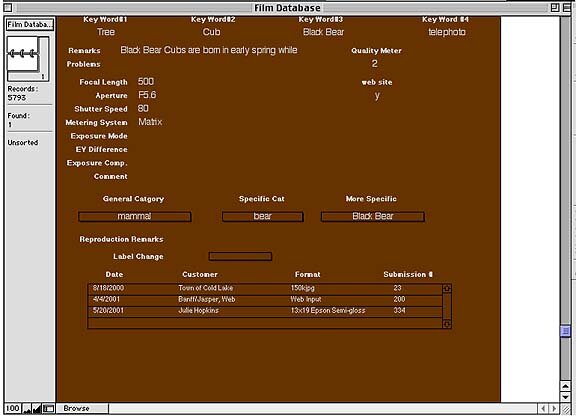

All Images And Text On This Site Are Copyright 1999-2001
by
Thomas D. Hill Jr.

| ABOUT KEIKO |
| WHAT'S NEW |
| THE KEIKO GALLERY |
| EQUIPMENT |
| IMAGE OF THE MONTH |
| ARTICLE OF THE MONTH |
20 May 01
Making great images is hard enough without having to deal with the technical portions of photography. The whole idea of trying to understand exposure is enough to make anyone quit. Add on the idea that shutter speeds will determine whether a subject is frozen or time or slightly blurred looking like it's forever running is enough to make any head spin. Then thinking of isolating a subject with varying DOF all adds up to an incredible amount of technical data to keep together just for the simple act of taking a picture. There's just so many things to think about. So, what about adding on the task of recording your shot information for each image and then noting that information in a database? That's waaaay to much technical stuff. Yes it is. But there's a reason to do all that extra work.
Early in my photography career I read everything I could related to photography. Books, magizines, everything there was about photography. Beyond the images, tips, and generally great info I got from reading all this stuff I was particularly impressed with the technical data associated with each image. Most publications seemed to have all the shutter speed and aperture information needed to duplicate the image. I remembered viewing each of these professionally made images and tried to imagine what I would do given the same set of information. Adding the technical data seemed to make the image more vivid and it helped me to understand the basics of photography.
Sometime early on, I decided I wanted to record the same info for each of my images. I thought properly recording it was a necessary aspect in photography. When I started I hadn't fully anticipated why I wanted the info. I only knew the top Pros recorded it so If I ever wanted to be one of them I had to tackle this. So began the quest to record my exposure data. I found a note pad that would fit in my backpack and carried it around whenever I was out in the field. I recorded everything at first. The lighting conditions, the film used, the basic exposure information. Eventually I settled on a tiny subset of this but the basics were there--shutterspeed, aperture, exposure compensation, filters, and film used. All the other stuff didn't seem to matter as much.
To be useful, I knew I couldn't keep all the data on my notepad. I had to keep it in something more useful. Not only that, I saw lots of people printed labels for each of their slides. I think that could easily be accomplished using Excel or even Word. I created an Excel spreadsheet that covered all of my recorded data and more. Eventually, I outgrew Excel. I was demanding too much from Excel and honestly the queries of basic database management program far outstripped Excel for basic searching and sorting. I began a self-taught adventure learning the ins and outs of Filemaker Pro to develop my first database and the product you see below. Even though it tooks lots of learning, some sweat, and a couple tears, the effort was paid-off the first time I conducted a search looking for a particular image. The result was extremely impressive.
The best part of my database is the exposure information. Imagine embarking on a once and a lifetime trip to shoot pictures of polar bears in Churchill. An extrememly complicated exposure situation--white subject on white background. Before risking wasting the opportunity because of poor exposure control, how about reviewing previously collected data taken under similar circumstances by using your own database. All you would have to do is search your database to come up with similar images you previously shot. Examine the compensation technique you used assess how applicable how that situation might appropriate for your white on white adventure. Think of it as kind of a tune-up prior to the big game. Enough about why I use one. Let's look at what I've got.



In the end, databases take a lot of care and feeding to ensure they're up to date. Unfortunately, I think it can soak up a lot of time that may be been used out in the field shooting pictures instead of geeking at a computer. There are direct benefits especially if you're managing thousands of slides and you need to know where a particular image is store in you vast library. Also, all the information can eventually be useful in ways you never imagined before.
Cheers
Tom